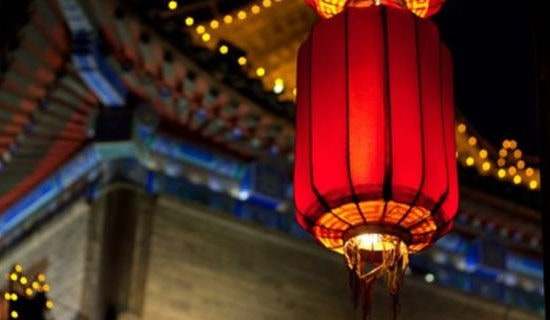关于春节英文资料
临近春节,需要用到春节资料的地方比较多,那么关于春节英文资料不知道你又掌握到了没有呢?下面就随小编一起去阅读关于春节英文资料,相信能带给大家启发。

英文版春节对联的来历
Spring Couplets, a Chinese New Year decoration, are an integral part of China's New Year. Their beginnings go back as far as the origins of New Year's festivities.
春联,是中国新年的装饰,没有春联,春节就不完整。春联的来历就要说到新年的来历
According to legends in the China's ancient past there was a monster known as Nian who often came down from the mountains to eat livestock and locals. It was discovered that he was afraid of the color red and so red paper was placed around doors and windows of houses and poems for good luck were added to them. The houses with the red paper were avoided by the monster, so its inhabitants were spared. The tradition has continued until today.
根据中国古代历史传说中记载,有一个叫“年的”怪物经常从山上到村子里吃牲畜。后来人们发现这个怪物怕洪泽,所以就在门上,窗户上贴红纸,红纸上面还写一些增加转运的诗。这样,怪兽害怕贴满红纸的屋子,所以这个风俗被流传了下来,一直直到今天。
Couplets are traditionally painted with black ink on two pieces of red paper which is then hung on either side of a door.
对联传统的来讲是用黑墨在两张红纸上写字,然后贴在门的两侧。
One half is hung on either side. There is an extra piece of paper painted with words of prosperity hung above the door frame. Traditionally the couplets are poems consisting of two lines of either four or five characters. They are painted from top to bottom, right to left.
一边贴张。另外还有一个横批写着意味繁荣之意之字贴在门框的上方。传统的对联,上联合下联是4个或5个字,是一对诗。写对联一般是从上到下,从右到左。
Different couplets have different themes. For farmers the couplets are meant to bring bounty to them, whereas businessmen's couplets are meant to bring money. Traditionally scholars would paint couplets and give them to their friends, relatives, and the public. Many people choose to create their own couplets. Many times Door God or the Character "Fu"is added to doors along with the couplets.
不同的对联有不同的`主题。比如,给农民的对联是带来好收成,商人挣跟多钱。传统学者会自己写对联赠予朋友或亲人。许多人会自己设计属于自己的对联。门神和福字一般都是和对联配套的贴在门上的。
1.celebrates the new year, thousand villages shoot off firecrackers, ten thousand households write the association, the happy artillery spring festival couplet awakes the informer
2016关于春节黑板报中英文资料
庆新年,千村鸣炮,万户撰联,喜炮春联醒耳目.
扬正气,九野响雷,兆民击鼓,惊雷警鼓壮河山.
2.raises the healthy tendency, nine wild thunder, the common people beat a drum, startling thunderclap alarm drum strong landscape
pink willow green, the hawk song, the firecracker fireworks welcomes the prosperous times
the world at peace, the year abundant person is long-lived, the song of victory graceful dance celebrates the early spring
桃红柳绿,燕舞莺歌,爆竹烟花迎盛世.
海晏河清,年丰人寿,凯歌曼舞庆新春.
春节的来历
The Chinese New Year is now popularly known as the Spring Festival because it starts from the Begining of Spring (the first of the twenty-four terms in coodination with the changes of Nature). Its origin is too old to be traced. Several explanations are hanging around. All agree, however, that the word Nian, which in modern Chinese solely means "year", was originally the name of a monster beast that started to prey on people the night before the beginning of a new year.
One legend goes that the beast Nian had a very big mouth that would swallow a great many people with one bite. People were very scared. One day, an old man came to their rescue, offering to subdue Nian. To Nian he said, "I hear say that you are very capable, but can you swallow the other beasts of prey on earth instead of people who are by no means of your worthy opponents?" So, it did swallow many of the beasts of prey on earth that also harrassed people and their domestic animals from time to time.
After that, the old man disappeared riding the beast Nian. He turned out to be an immortal god. Now that Nian is gone and other beasts of prey are also scared into forests, people begin to enjoy their peaceful life. Before the old man left, he had told people to put up red paper decorations on their windows and doors at each year's end to scare away Nian in case it sneaked back again, because red is the color the beast feared the most.From then on, the tradition of observing the conquest of Nian is carried on from generation to generation. The term "Guo Nian", which may mean "Survive the Nian" becomes today "Celebrate the (New) Year" as the word "guo" in Chinese having both the meaning of "pass-over" and "observe". The custom of putting up red paper and firing fire-crackers to scare away Nian should it have a chance to run loose is still around. However, people today have long forgotten why they are doing all this, except that they feel the color and the sound add to the excitement of the celebration.
春节,是农历的岁首,也是我国古老的传统节日。古代过“年”不是在腊月二十九日或三十日,而是在“蜡日”,即后来的“腊八”。南北朝以后,把“蜡祭”移至岁末。到了民国时 ,改用阳历,才把阴历年叫“春节”,因为春节一般都在“立春”前后。
春节是我国最盛大、最热闹的一个古老传统节日。俗称“过年”。按照我国农历,正月初一古称元日、元辰、元正、元朔、元旦等,俗称年初一,还有上日、正朝、三朔、三朝、三始、三元等别称,意即正月初一是年、月、日三者的开始。
春节,顾名思义就是春天的节日。春天来临,万象更新,新一轮播种和收获季节又要开始。 人们有足够的理由载歌载舞来迎接这个节日。于是,节前就在门脸上贴上红纸黄字的新年寄语。
春节的另一名称叫过年。“年”是什么呢?是一种为人们带来坏运气的想象中的动物。“年”一来。树木凋蔽,百草不生;“年”一“过”,万物生长,鲜花遍地。“年”如何才能过去呢?需用鞭炮轰 ,于是有了燃鞭炮的习俗。1993年,北京市人民政府颁布了禁放烟花爆竹的法律,使这一沿续了几百年的习俗成为历史。
春节是个亲人团聚的节日,这一点和西方的圣诞节很相似。离家的孩子这时要不远千里回到父母家里。真正过年的前一夜叫“除夕”,又叫“团圆夜”,“团年”。传统的庆祝活动则从除夕一直持续到正月十五元宵节。喜庆气氛要持续一个月。 正月初一前有祭灶、祭祖、 扫除污秽。三十日要贴门神、对联、挂旗、吃饺子、放鞭炮,除夕“守岁”等 仪 式;正月初一晚辈向长辈拜年,然后至亲友家贺年。亲友第一次见面时,说些“恭贺新喜”、“恭喜发财”、“恭喜”、“过年好”等话,互相祝贺。
【关于春节英文资料】相关文章:
英文春节手抄报资料12-16
春节手抄报资料英文怎么写03-10
关于妇女节英文资料11-11
元旦英文资料09-27
关于春节黑板报资料01-15
元旦的英文资料09-29
元旦英文小报资料09-28
关于春节黑板报春节资料大全01-17
关于春节学生黑板报资料01-16
2016关于春节黑板报资料01-16